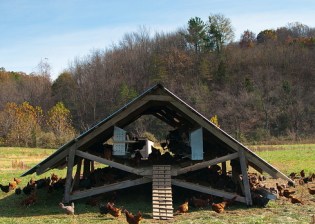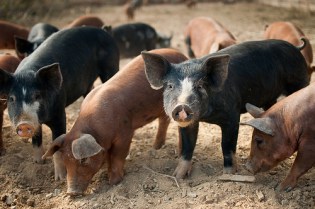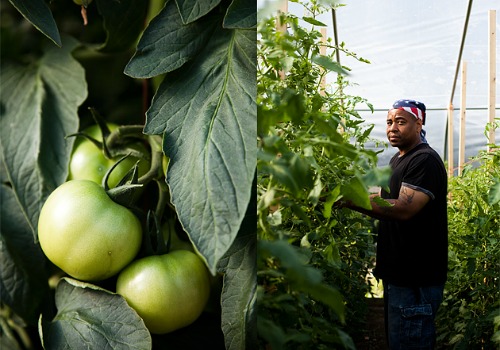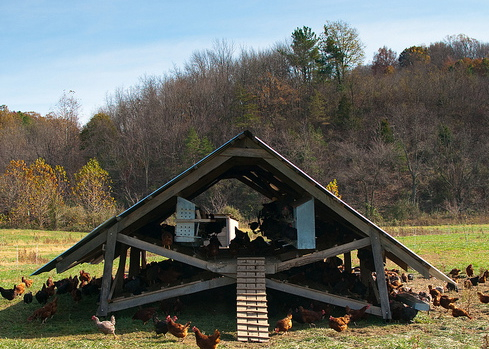Editor’s note: What follows is an excerpt from Joel Salatin’s latest book, Folks, This Ain’t Normal. Taken from the chapter called “We Only Serve White Meat Here,” the passage illustrates the relationship Salatin’s farm, Polyface, has with the national chain Chipotle, and takes a critical look at the “mismatch between today’s fast food industry and the local food system.”

Pasture-raised chickens on Polyface Farm. (Photo by Dane Brian.)
As a small farmer, I need to sell the whole animal. So does the food industry, and it’s invented ingenious ways to do that by locating a steak house on one corner and a burger joint on the other. Between the two, the whole animal gets used. But fast food, because of its volume and narrow-spectrum use, inherently creates a conundrum for local supply.
Our experience with the wonderful fast food restaurant chain Chipotle Mexican Grill has really brought this home to me. This is one fast food outfit whose heart is definitely in the right place. They keep pushing the envelope on local sourcing and ecologically friendly food. Using traditional long- and slow-cooking techniques, open kitchens, and integrity sourcing, their innovations have created quite a stir in the fast food industry.
In full disclosure, our farm has been the pork supplier for their Charlottesville [Va.] restaurant since 2008 and for their Harrisonburg [Va.] location since it opened in 2010. I think explaining a bit of this story might help put things in perspective. By the time Chipotle approached us about being a supplier, our farm was servicing some 30 restaurants — mostly white tablecloth — in western and central Virginia. In short, we are a large player in the local food sourcing scene.
When Steve Ells, founder of Chipotle, first visited our farm, he really wanted the pastured chicken. But when we figured up how many chickens it would take to supply just one restaurant, it totaled some 2,000 per week because they only use dark meat. It’s juicier than the white. We would have had to find another outlet for the breasts. And of course they wanted a steady supply year-round. Pastured poultry on a foot of snow when the temperature is zero is not a good combination. And the chicken for Chipotle would need to be deboned, and processed under federal inspection. This kind of service is not available in our area — at least to operations like ours. Too many hurdles. Forget the chicken.
After realizing the difficulty with chicken, our attention turned to pork. Here again, the narrow buying spectrum raised its ugly head: only shoulders and a volume of 300-500 pounds a week. That was out of our range because it would require 12 to 18 hogs per week. And we would have to move the rest of the pork elsewhere. I suggested that they try our hams along with the shoulders, to see if a blend would still be juicy enough.

Pigs or "pigaerators" at Polyface farm. (Photo by Dane Brian.)
Shoulder is juicier than ham. Steve agreed to try and, sure enough, found that our hams were juicier than the meat of their other suppliers, so we could use a 50-50 blend. That dropped our weekly hog numbers to six to eight, which was much more doable. Those numbers were still a stretch for us, but they were within eyesight. Our upscale restaurants were delighted to see more loins and bellies become available. The only problem then was the sausage. I joked with Steve that he needed to offer a breakfast in order to diversify his vendor portfolio, to take a broader range of product. But like any successful entrepreneur, he didn’t want to mess around with what was clearly a winning combination by adding menu items or changing store hours. Eventually our family customers and hot dogs have handled the sausage, which is made from the trim and salvage parts of the carcass.
I joked with Steve, “Well, sure it works, but only as long as you can cherry-pick parts and pieces from a warehouse supply chain and truck things long distances.” That’s the conundrum facing any narrow-spectrum use venue like a fast food place. It works in the current context. Is the current context sustainable? I would argue that it is not, as illustrated by these stories.
I am certainly not trying to downplay Chipotle’s effort — our farm has a wonderful working relationship with Steve and the whole outfit. But I also don’t shy away from nudging and pushing and educating. This has been a delightful dance, I think for both of us, and it’s not over yet.
Beef has been on the negotiating table for a while, but we haven’t yet been able to get together on price and volume. Again, Chipotle only uses about 18 percent of the carcass, so any supplier needs to find a home for the rest of the critter. The bottom line is that the lack of variety in the fast food simple-menu model creates an inherent inaccessibility to small-scale local producers who need to move the whole animal. The only way a narrow-spectrum fast food place can exist is to be able to cherry-pick from a big enough inventory pool.
In this regard, the specialization, simplification, and routinization of the fast food model discourages access by nonindustrial local farms. While we smaller local farms may produce a significant volume of product, we don’t normally do enough of any piece of an item to supply such a narrow protocol in such volume. In this respect, the fast food industry has been a driving force in changing the landscape of the food system.

Photo by Dane Brian.
The old combination diner, offering a wider spectrum, nests better into a local food landscape. Another option would be for a couple of narrow-spectrum restaurants to collaborate in a locality, so that one could take a couple of items and the other could take complementary items. This would offer the local farmer a symbiotic marketing option.
If Chipotle, for example, could get Shoney’s to offer local pigaerator sausage and bacon, then more of the animal could get used. On another corner, if a TGI Friday’s would offer the loin, that would just about take care of the whole animal. That’s the kind of collaboration that is really necessary to increase local food penetration in the marketplace — and that’s just one animal.
Old-style diners that often served liver and onions or braised short ribs or chicken and dumplings used a much greater variety. They weren’t afraid to nibble around the edges, to help salvage peripheral items. I’m thinking stewed tomatoes (a great place for blemished produce) and heavy soups. Squash bisque — that’s where the blemished squash goes. Have you ever seen squash on a fast food menu? Squash is a wonderful, underutilized food.
Intensive farms serving local markets tend to be multispeciated, like ours. This was the problem we had dealing with Whole Foods. They only wanted our eggs. At Polyface, our animals are in balance. We can’t have more eggs than we have cows to mow ahead of the Eggmobiles. The pigs turn the compost behind the cows. Everything needs to come up together to leverage the gifts and talents of each. This intricate symbiosis only works if it stays in balance. Whole Foods didn’t want anything but eggs. They wanted to turn us into an egg farm. We don’t want to just be an egg farm. The eggs are a byproduct of chicken function, biological sanitizing under rabbits, behind cows.
The same is true for vegetables. Intensive farms achieve their hyperproductivity partially due to planting a variety. Cool-season vegetables in the spring double-cropped to hot-season vegetables in the summer. If the season is long enough, and with tall tunnel extenders, perhaps the same ground can go back into a cool-tolerant vegetable in the fall. That’s three crops to make the system work and achieve the yields necessary for small acreages to be profitable.
That is exactly what industrial monocropping systems can’t do as well. The unfair advantage, to use a business term, enjoyed by the smaller local producer is this ability to achieve higher productivity per square yard through synergistic crop variation. That requires lots of varieties. How many varieties are in fast food? Let’s see, tomato, lettuce, pepper, onion. Did I miss something? That’s not much variety. And therein lies the mismatch between today’s fast food industry and the local food system.
You see, historically normal food systems were not only local; they were also diversified. The whole notion that a region grows only one thing has always doomed itself to fail. The Irish potato famine and King Cotton in the South were historical aberrations. Historically normal farming systems were highly diverse, with mixed animals and plants — such as we see in vibrant natural ecosystems.




